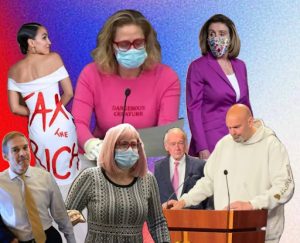For our congresswomen, fashion isn’t just a choice–it’s strategy.
BY NYLAH MITCHELL, STAFF WRITER
Editor’s Note: This article is a shortened version of an original piece from the writer. To read the original-length piece, visit here.
It’s often forgettable when male politicians wear the usual dark suits and their party-colored ties; however, what’s unforgettable are the outfits congresswomen don in the Capitol halls. Their outfits draw attention not because they’re deemed cute or ugly but because of the indication of their politics, language and credibility. The controversial nature of what they wear is always a topic of conversation as it breaks from the traditional modesty culture on Capitol Hill.
This extends beyond Washington when politicians attend the most prestigious and glamorous fashion event of the year: the Met Gala. Rep. Alexandria Ocasio-Cortez sparked controversy when she wore a white Brother Vellies gown with a ruby-red message on the back: “Tax The Rich.” Critics opined that the irony of attending a $35,000-a-ticket event while wearing a “Tax The Rich” message on her dress put Ocasio-Cortez in a complicated position.
But it’s not just Ocasio-Cortez making statements. Sen. Kyrsten Sinema presided over the Senate wearing a hot pink top reading “Dangerous Creature.” When Sen. Mitt Romney told Sinema that she was “breaking the internet.” She responded, “good.”
In a telephone interview, Vanessa Friedman, chief fashion critic at The New York Times, stated “Sinema choosing not to wear that kind of boring navy suit is an absolutely conscious decision to say something about who she is and how her colleagues expect her to behave. She is talking to her constituents, she’s talking to the rest of Congress, she’s talking to everyone who sees her with her clothing. And there is nothing demeaning about acknowledging that.”
It would be remiss to claim that in the new age of politics, there isn’t a fashion revolution occurring right before our eyes. The revolution introduces a break from tradition, norms and values as Congress members dress outside the typical dark suit. It’s strategic, in a sense.
“Women have a much broader array of choices in what they wear than men do. And that gives them a lot more opportunity for using their clothing as tools to send different messages,” said Friedman.
On the flip side, while most men conform to wearing a suit at all times, Rep. Jim Jordan doesn’t. One of the biggest controversies surrounding Jordan arose when he removed his suit jacket during a committee hearing.
“When I’m in committee, I get fired up at these witnesses who, I think, aren’t being square with me or my colleagues and, more important, the American people. I can’t really get fired up and get into it if you’ve got some jacket slowing you down,” said Jordan.
Consider Sen. John Fetterman who arrived at the Senate in a hoodie and basketball shorts over two years ago. Majority Leader Chuck Schumer later relaxed the informal dress code requiring senators in a suit jacket and dress shoes. “Senators are able to choose what they wear on the Senate floor,” Schumer said.
But what does a member of Congress or senator’s outfit tell constituents about themselves?
According to National Journal reporter Lauren Green, “Their outfits definitely tell a story because you do look at the typical Republican and there’s a stereotype in what they wear. The navy suit, the red tie—hat is very common. But I think that my viewers see them more as human.
I think we’re so used to seeing them buttoned up, like on places like CNN or C-SPAN, versus seeing them on a casual TikTok video. It lets people know these members are just like us, going to work every day. I think it’s less of what they’re wearing and more about the perception that they’re actually human in my videos,”
Green creates “outfit of the day” (aka ‘OOTD’) TikTok videos featuring congress members. She typically shares what she’s wearing at the Capitol before handing it over to the member for them to describe their outfit.
Even when a congresswoman simply shares her outfit with followers, she must often defend her choices and take an unapologetic stance . “Any woman in the political public eye has to make a decision about her clothes,” Friedman wrote. She has to show that she knows what she’s doing “because as a woman, her clothes will be used to diminish and define her.“
Congress as an institution evolves as the people evolve, electing politicians who best represent them. The evolution happens when someone creates conversations on topics beyond policy. It’s why fashion is increasingly weaponized to push subtle politics and ideologies.
While it may come with critics and controversy, through strategy, congress will continue to revolutionize the institution through their fashion as time progresses.




